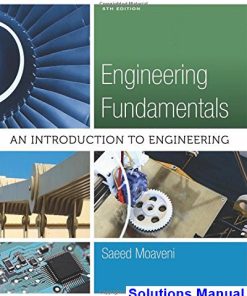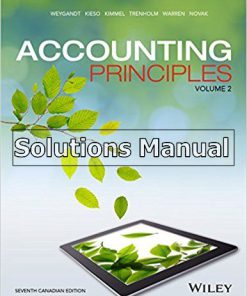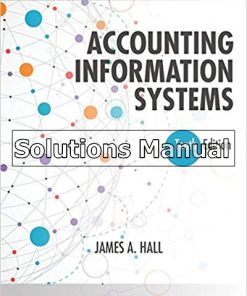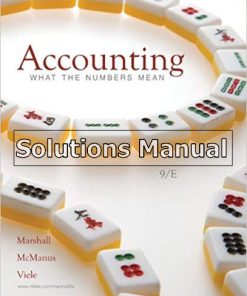Materials Science and Engineering An Introduction 9th Edition Callister Solutions Manual
$26.50$50.00 (-47%)
Materials Science and Engineering An Introduction 9th Edition Callister Solutions Manual.
You may also like
Materials Science and Engineering An Introduction 9th Edition Callister Solutions Manual
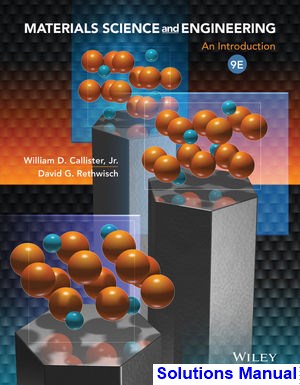
Product details:
- ISBN-10 : 1118477707
- ISBN-13 : 978-1118477700
- Author: William D. Callister
Building on the extraordinary success of eight best-selling editions, Callisters new Ninth Edition of Materials Science and Engineering continues to promote student understanding of the three primary types of materials (metals, ceramics, and polymers) and composites, as well as the relationships that exist between the structural elements of materials and their properties. This edition is again supported by WileyPLUS, an integrated online learning environment, (when ordered as a package by an instructor). Also available is a redesigned version of Virtual Materials Science and Engineering (VMSE). This resource contains interactive simulations and animations that enhance the learning of key concepts in materials science and engineering (e.g., crystal structures, crystallographic planes/directions, dislocations) and, in addition, a comprehensive materials property database. The text is fully supported by WileyPLUS, an integrated online learning environment that contains the highly respected Virtual Materials Science and Engineering Lab (VMSE), a materials property database referenced to problems in the text, and new modules in tensile testing, diffusion, and solid solutions (all referenced to problems in the text).
Table contents:
-
- 1.1 The Material World
- 1.2 Materials Science and Engineering
- 1.3 Six Materials That Changed Your World
- STEEL BRIDGES—INTRODUCING METALS
- TRANSPARENT OXIDES—INTRODUCING CERAMICS
- SMARTPHONES AND TABLETS—INTRODUCING GLASSES
- NYLON PARACHUTES—INTRODUCING POLYMERS
- KEVLAR®-REINFORCED TIRES—INTRODUCING COMPOSITES
- SILICON CHIPS—INTRODUCING SEMICONDUCTORS
- 1.4 Processing and Selecting Materials
- 1.5 Looking at Materials by Powers of Ten
PART I: The Fundamentals
- Atomic Bonding
- 2.1 Atomic Structure
- 2.2 The Ionic Bond
- COORDINATION NUMBER
- 2.3 The Covalent Bond
- 2.4 The Metallic Bond
- 2.5 The Secondary, or van der Waals, Bond
- 2.6 Materials—The Bonding Classification
- Crystalline Structure—Perfection
- 3.1 Seven Systems and Fourteen Lattices
- 3.2 Metal Structures
- 3.3 Ceramic Structures
- Crystal Defects and Noncrystalline Structure—Imperfection
- 4.1 The Solid Solution—Chemical Imperfection
- 4.2 Point Defects—Zero-Dimensional Imperfections
- 4.3 Linear Defects, or Dislocations—One-Dimensional Imperfections
- 4.4 Planar Defects—Two-Dimensional Imperfections
- 4.5 Noncrystalline Solids—Three-Dimensional Imperfections
- Diffusion
- 5.1 Thermally Activated Processes
- 5.2 Thermal Production of Point Defects
- 5.3 Point Defects and Solid-State Diffusion
- 5.4 Steady-State Diffusion
- 5.5 Alternate Diffusion Paths
- Mechanical Behavior
- 6.1 Stress Versus Strain
- METALS
- CERAMICS AND GLASSES
- POLYMERS
- 6.2 Elastic Deformation
- 6.3 Plastic Deformation
- 6.4 Hardness
- 6.5 Creep and Stress Relaxation
- 6.6 Viscoelastic Deformation
- INORGANIC GLASSES
- ORGANIC POLYMERS
- ELASTOMERS
- 6.1 Stress Versus Strain
- Thermal Behavior
- 7.1 Heat Capacity
- 7.2 Thermal Expansion
- 7.3 Thermal Conductivity
- 7.4 Thermal Shock
- Failure Analysis and Prevention
- 8.1 Impact Energy
- 8.2 Fracture Toughness
- 8.3 Fatigue
- 8.4 Nondestructive Testing
- 8.5 Failure Analysis and Prevention
- Phase Diagrams—Equilibrium Microstructural Development
- 9.1 The Phase Rule
- 9.2 The Phase Diagram
- COMPLETE SOLID SOLUTION
- EUTECTIC DIAGRAM WITH NO SOLID SOLUTION
- EUTECTIC DIAGRAM WITH LIMITED SOLID SOLUTION
- EUTECTOID DIAGRAM
- PERITECTIC DIAGRAM
- GENERAL BINARY DIAGRAMS
- 9.3 The Lever Rule
- 9.4 Microstructural Development During Slow Cooling
- Kinetics—Heat Treatment
- 10.1 Time—The Third Dimension
- 10.2 The TTT Diagram
- DIFFUSIONAL TRANSFORMATIONS
- DIFFUSIONLESS (MARTENSITIC) TRANSFORMATIONS
- HEAT TREATMENT OF STEEL
- 10.3 Hardenability
- 10.4 Precipitation Hardening
- 10.5 Annealing
- COLD WORK
- RECOVERY
- RECRYSTALLIZATION
- GRAIN GROWTH
- 10.6 The Kinetics of Phase Transformations for Nonmetals
PART II: Materials and Their Applications
- Structural Materials—Metals, Ceramics, and Glasses
- 11.1 Metals
- FERROUS ALLOYS
- NONFERROUS ALLOYS
- 11.2 Ceramics and Glasses
- CERAMICS—CRYSTALLINE MATERIALS
- GLASSES—NONCRYSTALLINE MATERIALS
- GLASS-CERAMICS
- 11.3 Processing the Structural Materials
- PROCESSING OF METALS
- PROCESSING OF CERAMICS AND GLASSES
- 11.1 Metals
- Structural Materials—Polymers and Composites
- 12.1 Polymers
- POLYMERIZATION
- STRUCTURAL FEATURES OF POLYMERS
- THERMOPLASTIC POLYMERS
- THERMOSETTING POLYMERS
- ADDITIVES
- 12.2 Composites
- FIBER-REINFORCED COMPOSITES
- AGGREGATE COMPOSITES
- PROPERTY AVERAGING
- MECHANICAL PROPERTIES OF COMPOSITES
- 12.3 Processing the Structural Materials
- PROCESSING OF POLYMERS
- PROCESSING OF COMPOSITES
- 12.1 Polymers
- Electronic Materials
- 13.1 Charge Carriers and Conduction
- 13.2 Energy Levels and Energy Bands
- 13.3 Conductors
- THERMOCOUPLES
- SUPERCONDUCTORS
- 13.4 Insulators
- FERROELECTRICS
- PIEZOELECTRICS
- 13.5 Semiconductors
- INTRINSIC, ELEMENTAL SEMICONDUCTORS
- EXTRINSIC, ELEMENTAL SEMICONDUCTORS
- COMPOUND SEMICONDUCTORS
- PROCESSING OF SEMICONDUCTORS
- SEMICONDUCTOR DEVICES
- 13.6 Composites
- 13.7 Electrical Classification of Materials
- Optical and Magnetic Materials
- 14.1 Optical Materials
- OPTICAL PROPERTIES
- OPTICAL SYSTEMS AND DEVICES
- 14.2 Magnetic Materials
- FERROMAGNETISM
- FERRIMAGNETISM
- METALLIC MAGNETS
- CERAMIC MAGNETS
- 14.1 Optical Materials
- Materials in Engineering Design
- 15.1 Material Properties—Engineering Design Parameters
- 15.2 Selection of Structural Materials—Case Studies
- MATERIALS FOR HIP- AND KNEE-JOINT REPLACEMENT
- METAL SUBSTITUTION WITH COMPOSITES
- 15.3 Selection of Electronic, Optical, and Magnetic Materials—Case Studies
- LIGHT-EMITTING DIODE
- GLASS FOR SMART PHONE AND TABLET TOUCH SCREENS
- AMORPHOUS METAL FOR ELECTRIC-POWER DISTRIBUTION
- 15.4 Materials and Our Environment
- ENVIRONMENTAL DEGRADATION OF MATERIALS
- ENVIRONMENTAL ASPECTS OF DESIGN
- RECYCLING AND REUSE
APPENDIX 1: Physical and Chemical Data for the Elements
APPENDIX 2: Atomic and Ionic Radii of the Elements
APPENDIX 3: Constants and Conversion Factors and the Periodic Table of Elements
APPENDIX 4: Properties of the Structural Materials
APPENDIX 5: Properties of the Electronic, Optical, and Magnetic Materials
APPENDIX 6: Glossary
Answers to Practice Problems (PP) and Odd-Numbered Problems
Index
People also search:
materials science and engineering an introduction 9th edition
materials science and engineering an introduction 9th edition solutions pdf
materials science and engineering an introduction 9th edition solution manual
energy science and engineering syllabus
introduction to materials science for engineers 9th edition






